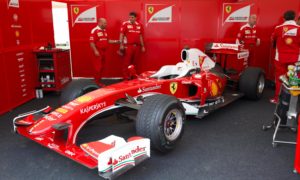F1 cars run at approximately 4 miles per gallon.
Fuel is one of the most vital factors of a race. A full load of fuel on an F1 car will weigh about 75kg. This is more than 10 percent of the car’s weight so a car on an empty tank will feel a lot different to one with a full tank. A lighter car will usually be more nimble around corners, give the car lighter steering and causes less tyre wear and suspension punishment.
Teams will often test cars with both full and empty tanks to work out how the car’s handling will be affected by the change in fuel load. This testing has a big impact on a team’s pitstop strategy for the race.
The fuel tank itself is located just behind the cockpit. It is placed here because it is the strongest part of the car and the tank itself is kevlar-reinforced rubber to make it as strong as possible. This is to ensure that the car is as safe as possible. During a pitstop, fuel will be pumped into the car at approximately 12 litres per second – that’s 25 times faster than a garage forecourt!
Fuel density can be altered and special lightweight fuels are often used in F1 cars. Different fuel make-ups may be used in different races. In a race such as Monaco or Hungary where more responsiveness from the throttle is needed, combustion enhancers may be added to the fuel.
During a typical season a Formula One team will use over 200,000 litres of fuel for testing and racing








